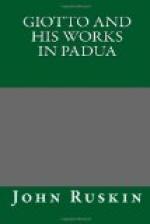It was before noticed that the chapel was built between 1300 and 1306. The architecture of Italy in the beginning of the fourteenth century is always pure, and often severe; but this chapel is remarkable, even among the severest forms, for the absence of decoration. Its plan, seen in the marginal figure on p. 26, is a pure oblong, with a narrow advanced tribune, terminating in a trilateral apse. Selvatico quotes from the German writer Stieglitz some curious observations on the apparent derivation of its proportions, in common with those of other buildings of the time, from the number of sides of its apse. Without entering into these particulars, it may be noted that the apse is just one-half the width of the body of the chapel, and that the length from the extremity of the tribune to the west end is just seven times the width of the apse. The whole of the body of the chapel was painted by Giotto; the walls and roof being entirely covered either with his figure-designs, or with various subordinate decorations connecting and enclosing them.
The woodcut on p. 27 represents the arrangement of the frescoes on the sides, extremities, and roof of the chapel. The spectator is supposed to be looking from the western entrance towards the tribune, having on his right the south side, which is pierced by six tall windows, and on which the frescoes are therefore reduced in number. The north side is pierced by no windows, and on it therefore the frescoes are continuous, lighted from the south windows. The several spaces numbered 1 to 38 are occupied by a continuous series of subjects, representing the life of the Virgin and of Christ; the narrow panels below, marked a, b, c, &c., are filled by figures of the cardinal virtues and their opponent vices: on the lunette above the tribune is painted a Christ in glory, and at the western extremity the Last Judgment. Thus the walls of the chapel are covered with a continuous meditative poem on the mystery of the Incarnation, the acts of Redemption, the vices and virtues of mankind as proceeding from their scorn or acceptance of that Redemption, and their final judgment.
The first twelve pictures of the series are exclusively devoted to the apocryphal history of the birth and life of the Virgin. This the Protestant spectator will observe, perhaps, with little favour, more especially as only two compartments are given to the ministry of Christ, between his Baptism and Entry into Jerusalem. Due weight is, however, to be allowed to Lord Lindsay’s remark, that the legendary history of the Virgin was of peculiar importance in this chapel, as especially dedicated to her service; and I think also that Giotto desired to unite the series of compositions in one continuous action, feeling that to have enlarged on the separate miracles of Christ’s ministry would have interrupted the onward course of thought. As it is, the mind is led from the first humiliation of Joachim to the Ascension of Christ in one unbroken




